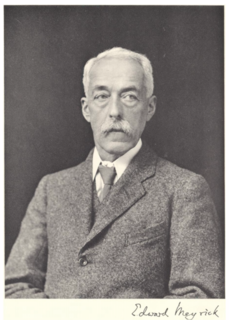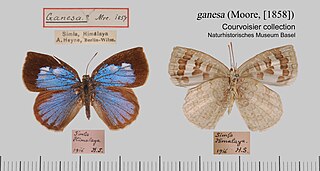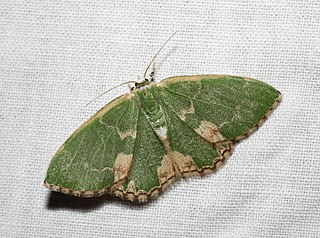Related Research Articles

Osmunda is a genus of primarily temperate-zone ferns of family Osmundaceae. Five to ten species have been listed for this genus.

Edward Meyrick FRS was an English schoolmaster and amateur entomologist. He was an expert on microlepidoptera and some consider him one of the founders of modern microlepidoptera systematics.

Athyrium (lady-fern) is a genus of about 180 species of terrestrial ferns, with a cosmopolitan distribution. It is placed in the family Athyriaceae, in the order Polypodiales. Its genus name is from Greek a- ('without') and Latinized Greek thyreos ('shield'), describing its inconspicuous indusium . The common name "lady fern" refers in particular to the common lady fern, Athyrium filix-femina.

Urodidae or "false burnet moths" is a family of moths in the lepidopteran order, representing its own superfamily, Urodoidea, with three genera, one of which, Wockia, occurs in Europe.

The butterfly subtribe Euptychiina is a diverse group within the tribe Satyrini, occurring throughout Central and South America, in addition to a few species known from North America. Euptychiina is a predominantly lowland group, with the exception of one Asian taxon Palaeonympha opalinaButler, 1871 and the Andean genus ForsterinariaGray, 1973. The taxon was erected by Lee Denmar Miller.

Arhopala ganesa, the tailless bushblue, is a species of lycaenid or blue butterfly found at the junction of the Palearctic realm and the Indomalayan realm.

Tongeia is a Palearctic genus of butterflies in the family Lycaenidae found in temperate East Asia. Most species are endemic to China and many species are recently described from China. The best known species is the more widely distributed Tongeia fischeri.

Ancylolomia is a genus of moths of the family Crambidae described by Jacob Hübner in 1825.

Elophila is a genus of moths of the family Crambidae described by Jacob Hübner in 1822.

Eristena is a genus of moths of the family Crambidae.

Udea is a genus of snout moths in the subfamily Spilomelinae of the family Crambidae. The genus was erected by Achille Guenée in 1845. The currently known 214 species are present on all continents except Antarctica. About 41 species are native to Hawaii.

Parapoynx is a genus of moths of the family Crambidae described by Jacob Hübner in 1825.
Pessocosma is a genus of moths of the family Crambidae.

Comibaena is a genus of moths in the family Geometridae. It was described by Jacob Hübner in 1823.

Bityla sericea is a species of moth in the family Noctuidae. This species is endemic to New Zealand. It is classified as "At Risk, Naturally Uncommon" by the New Zealand Department of Conservation.
Andropolia diversilineata is a moth in the family Noctuidae first described by Augustus Radcliffe Grote in 1877. It is found in western North America, from British Columbia south to California.
Koyaga falsa is a species of moth of the family Noctuidae first described by Arthur Gardiner Butler in 1885. It is found in China, Korea and Japan.

William Burgess Pryer was the first British Resident in Sandakan of North Borneo. Pryer's character is described as adventurous, diligent, and goal-oriented. For example, he knew that before exploring his career in Shanghai, he had explored large parts of the Spanish East Indies (Philippines), and he was a former amateur boxing champion.
Elophila fengwhanalis is a moth in the family Crambidae. It was described by Pryer in 1877. It is found in Japan, China and Korea.
Elophila interruptalis is a moth in the family Crambidae. It was described by Pryer in 1877. It is found in Japan, China and Korea.
References
- ↑ Beccaloni, G.; Scoble, M.; Kitching, I.; Simonsen, T.; Robinson, G.; Pitkin, B.; Hine, A.; Lyal, C., eds. (2003). "Lepidotarphius". The Global Lepidoptera Names Index . Natural History Museum.
- ↑ Savela, Markku. "Lepidotarphius Pryer, 1877". Lepidoptera and Some Other Life Forms. Archived from the original on November 3, 2012. Retrieved January 28, 2018.
| This article on a moth of the family Glyphipterigidae is a stub. You can help Wikipedia by expanding it. |